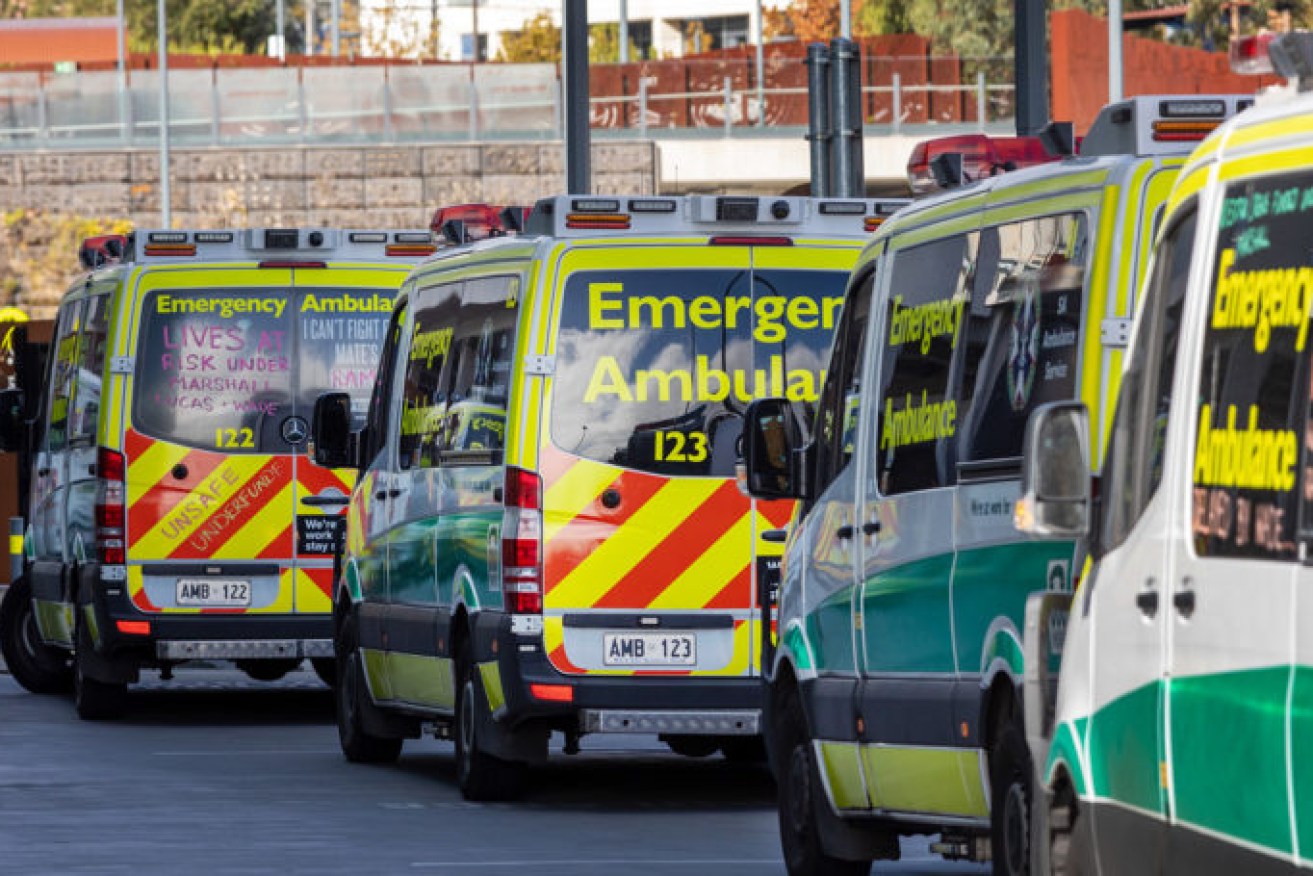Triple zero: Ambos raise alarm over COVID patients
UPDATED | A COVID patient waited three hours for an ambulance overnight while two other “critically unwell” cases had to be transported in the same ambulance due to resource shortages and were then ramped, the paramedics union says – but the Premier says all patients were seen in a “clinically appropriate timeframe”.


Ambulance ramping at the RAH (Photo: Tony Lewis/InDaily)
SA Health also denied the claims, releasing a statement this afternoon saying “no COVID patients were ramped on their presentation to the Royal Adelaide Hospital via ambulance last night – this includes a Category 1 patient who was seen immediately on arrival”.
“The COVID patient procedures were all followed correctly and all COVID patients were taken through the dedicated COVID entrance to the hospital,” the statement said.
It comes after the Ambulance Employees Association reported overnight that a COVID-19 patient triaged as a priority two case – requiring assistance within 16 minutes – waited three hours for an ambulance to arrive.
The inner northern suburbs patient was forced to wait as 21 ambulances were ramped at the Royal Adelaide Hospital by midnight, the union says.
In another incident, the union said three “critically unwell” COVID patients from the same family were dealt with as a “mass casualty incident” as there was only one ambulance to cover them for around 90 minutes.
The union said two of the patients had to be transported to hospital in the same ambulance after paramedics realised back up was not available. The two patients then spent time ramped at the RAH, the union said.
The incident has prompted the union to again launch industrial action, saying that from midday tomorrow paramedics will not charge any COVID positive case who is ramped.
The union notified SA Health CEO Chris McGowan and South Australian Ambulance CEO Rob Elliot of the action late this morning.
AEA general secretary Leah Watkins told InDaily that “it’s a really daunting situation to be in”.
“Last night we saw a very high workload, it was a combination of regular ambulance workload and COVID workload,” she said.
“There was on average 15 priority two cases uncovered through the whole night.”
SA Ambulance declared an “Opstat White” event at around 9:45pm on Wednesday, meaning “Operational capacity, capability and/or resources are insufficient to maintain effective service delivery for high acuity cases”.
9:45pm. SA Ambulance at critical Status White. Insufficient resources directly affecting patient safety. Every single Ambulance in Adelaide utilised, none avail for multiple uncovered emergencies. Significant Ramping. #saparli pic.twitter.com/Ogd3J9QXm9
— Ambulance Employees Association (SA) (@aeasa1981) December 22, 2021
Watkins said paramedics were also facing challenges with oxygen supplies for COVID patients on the ramp.
She said the amount of time paramedics spent at the home treating the three COVID-19 patients while waiting for backup meant they were “depleting their oxygen sources … to a dangerously low level”.
“They were ramped at the hospital with these declining oxygen levels,” Watkins said.
“If it got to a critical state, they would have had to … liaise with another one of the 21 other ambulances that were ramped and ask if they could borrow their oxygen.
“That’s a particularly dangerous situation if you’re taking medical equipment from one ambulance to give to another patient in this environment where patients are highly infectious with COVID.”
Watkins also highlighted that each ambulance needed to be “thoroughly” cleaned after transporting COVID or suspected COVID cases, increasing the turnaround time from one callout to the next.
But Premier Steven Marshall today rejected suggestions that COVID patients were forced to wait longer than necessary for treatment.
“There were four patients that I understand were transferred to the Royal Adelaide Hospital last night,” he told reporters.
“Three [were] from the one family, so it was perfectly acceptable for some of them to travel in the same ambulance.
“My understanding is that they were triaged, they were treated within the clinically appropriate timeframe.”
Asked about the AEA’s reports that a COVID patient waited three hours for an ambulance to arrive despite being triaged for 16 minutes, Marshall said: “No I don’t have any information that would suggest that was correct.”
“The reality is that we work through the acuity in a prioritised way,” he said.
“My advice was that everyone was seen within a clinically appropriate timeframe.”
Last night’s ramping comes just a day after InDaily reported that emergency clinicians had written to Health Minister Stephen Wade expressing their concern the state’s hospitals could become “overrun” when COVID cases rise.
South Australia recorded 198 new cases on Wednesday, on top of 154 on Tuesday and 105 on Monday.
SA Health has so far only publicly reported five COVID hospitalisations, although chief public health officer Nicola Spurrier warned on Tuesday that hospitalisations usually increase one to two weeks after a spike in cases.
Cases in New South Wales grew by nearly 2000 to 5715 overnight, with another 45 people hospitalised in the state with COVID-19.
The surge means 347 people in NSW are now in hospital with the virus, including 45 in ICU.
Victoria today reported 2005 new COVID-19 cases and 10 deaths, its highest figure since October 22. A total of 398 patients are in hospital, with 72 in intensive care and 39 on ventilators.
Watkins said the escalating caseload in South Australia is “significantly concerning” and is going to put a strain on ambulance resources for the state’s non-COVID patients.
“I don’t want to be that sky is falling person, but how can you not presume that there’s going to be avoidable deaths in the community when you’re taking three hours to get to a patient suffering a medical emergency?” she said.
“A priority two case is for people who are short of breath, heart attack, uncontrolled bleeding, head injuries, all that sort of thing, and we’re taking three hours to get to them now – that’s not quick enough to save someone’s life.”
InDaily contacted the South Australian Ambulance Service for comment.




